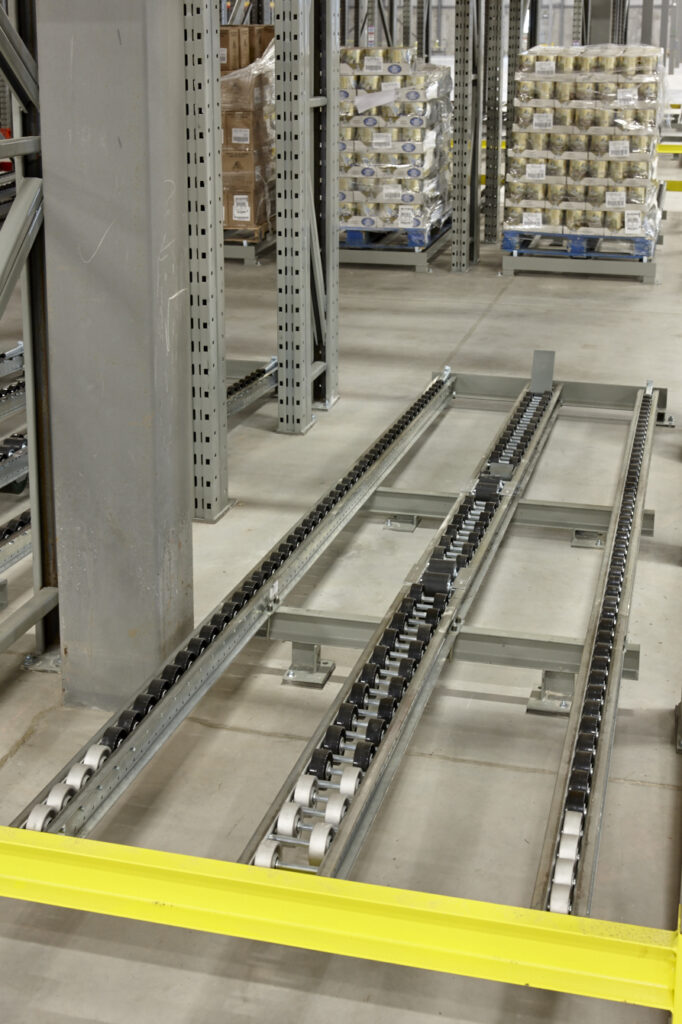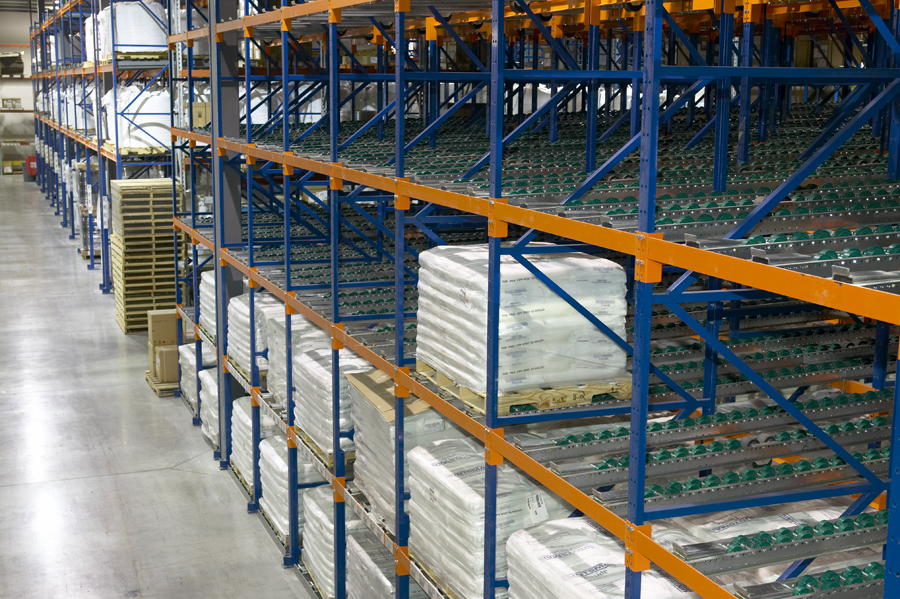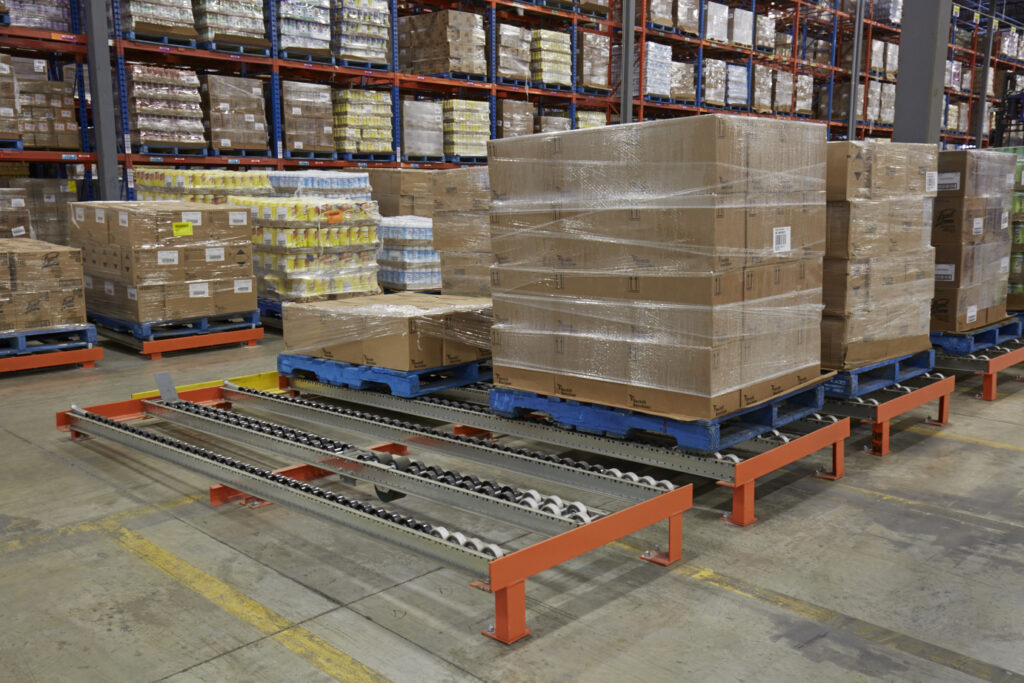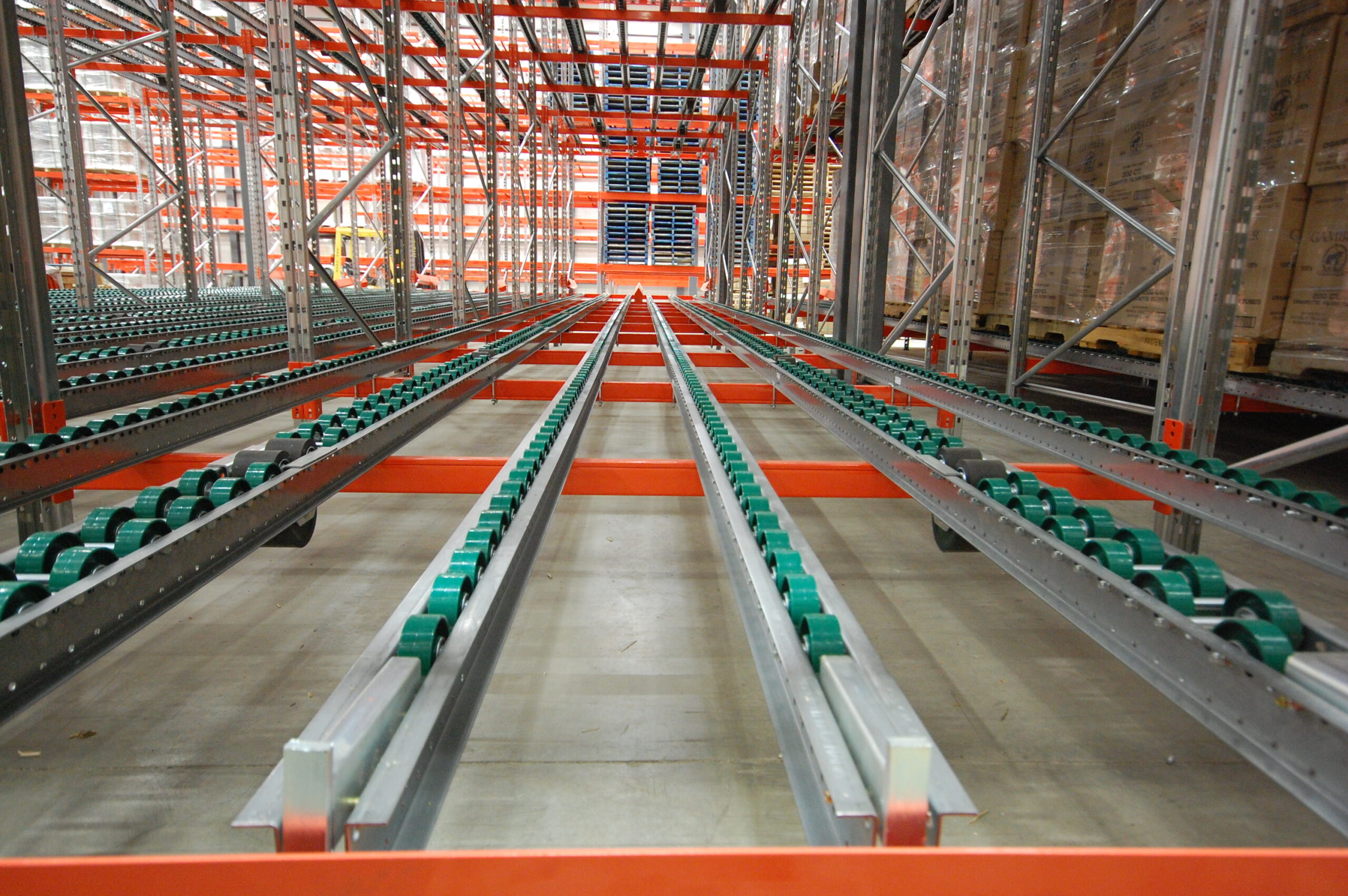Warehouses are always looking for ways to maximize space. One of the most effective methods is implementing gravity flow racking systems in your storage. These systems not only maximize space but are versatile in their application and efficient in inventory management. In this article, we will explore gravity flow racking and its benefits and provide insights on how businesses can effectively implement and take advantage of gravity flow racking systems. If you have any questions or want a free gravity flow installation quote, please contact us today!
Understanding Gravity Flow Racking Systems
Gravity flow racking systems are storage systems designed to use gravity to move products efficiently through warehouses or distribution centers. Gravity flow racking can be designed for either carton or pallet flow, depending on your warehouse needs. These systems operate on the principle of “first in, first out” (FIFO), ensuring that the oldest inventory is always at the front, ready for picking.
The Components
Gravity flow racking systems contain durable components built to last. The main components include:
- Roller tracks or wheels
- Inclined shelves or lanes
- Brakes and speed controllers
- Racking structure
- Support Beams and uprights
- Lane dividers and guides
The inclined rollers, or wheels, allow products to move forward under the influence of gravity. Rollers are typically used for lighter loads, and wheels are better for heavier loads. Your racks will be configured in lanes, and each lane is inclined at an angle to allow for the smooth movement of products from the loading end to the picking end.

Brakes or speed controllers can be integrated to control the speed of your product movement and prevent your products from moving too quickly down the incline. Your lane dividers and guides are what keep your products organized. They prevent products from mixing between lanes. These components work together to create a dynamic storage system that maximizes space efficiency and enhances your overall flow of goods.
Loading end and picking end
The loading and picking ends of gravity flow racks are integral to the functionality of your system. The loading end is where the picking process begins. Products are placed onto your gravity flow racking system and move down the incline toward the picking end. The picking end is where products reach the bottom of the incline and are ready to be retrieved. It is designed to facilitate easy access for picking operations.
Benefits of Gravity Flow Racking Systems
Gravity flow racks have several benefits that contribute to improved warehouse efficiency, better inventory management, and optimized use of storage space. We describe the key advantages of using gravity flow racks are described below:
Space Optimization:
Gravity flow racking systems make efficient use of the cubic space within your warehouse. The inclined lanes allow for high-density storage without requiring aisles between racks. As a result, you can store more products in your space compared to traditional selective pallet racks.
FIFO Inventory Management:
The FIFO principle ensures that products are retrieved in the order they were received. This is crucial for industries with perishable goods expiration dates. FIFO allows you to minimize the time products spend in storage and reduce the risk of product waste.
Enhanced Picking Efficiency:
Products in a gravity flow system automatically move forward and are picked from the front. This reduces the time and effort required for replenishment and speeds up the order-picking process. As a result, you can improve warehouse efficiency and increase order fulfillment rates.
Reduced Labor Costs:
Gravity flow racking creates an efficient workflow that optimizes your workforce and allows you to reallocate your resources to other areas in the supply chain. The streamlined picking process reduces the need for excessive labour in restocking and picking operations.
Versatility in Storage:
Your racking system can be customized to accommodate a wide range of products, including wood pallets, plastic pallets and totes. The depth of the system can range from 2 to 24 pallets deep. This adaptability makes them suitable for various industries, from e-commerce and retail to manufacturing and distribution.
For more information on the benefits of our gravity flow racking systems, read our article here.

Implementing a gravity flow racking system for warehouse space maximization requires careful planning, customization, and integration into your existing space. We have some expert tips to prepare yourself for your new gravity flow racking system:
1. Product Segmentation and Classification
Start by categorizing your products based on their demand patterns, size, and weight. This segmentation will help determine the appropriate configuration of your gravity flow racks for each product category. High-demand items may be placed in prime locations to gain easy access and optimize efficiency.
2. Customized Lane Configurations:
Next, we will tailor the lane configurations of your gravity flow racks to the specific needs of the products stored. Different products may require roller spacing, track length, and lane pitch variations to ensure smooth and controlled movement.
3. Regular Maintenance and Inspections:
Regularly maintain and inspect your gravity flow racking system to ensure optimal performance. During your inspections, check for damaged rollers, misalignments, or any obstructions that may impede the smooth flow of products. Timely repairs and upkeep contribute to the system’s longevity and prevent downtime.
4. Integration with Warehouse Management Systems (WMS):
Integrate the gravity flow racking system with a robust Warehouse Management System (WMS). This integration enables real-time monitoring of inventory levels, order status, and system performance. WMS can also provide data analytics to identify opportunities for further optimization.
5. Employee Training and Safety Measures:
Proper training for warehouse staff is crucial to safely and successfully implementing gravity flow racking systems. Educate your employees on the correct procedures for loading, unloading, and picking products from the racks. This will ensure your compliance with safety standards and increase your warehouse efficiency.
6. Continuous Improvement Strategies:
Regularly evaluate your gravity flow racking system’s performance and identify improvement areas. You can seek feedback from your warehouse staff and analyze data to make informed decisions on adjustments or expansions to the system. Continuous improvement is essential for staying ahead in the dynamic landscape of logistics.
Before installing a new gravity flow racking system, it is important to consult with a racking design expert to ensure you are optimizing your space efficiently and safely.

4 Common Applications of Gravity Flow Racking
Gravity flow racking benefits many industries where efficient storage, retrieval, and inventory management are crucial. Some common uses for gravity flow racking include:
1. Manufacturing, Warehouses and Distribution Centres
The most common application of gravity flow racking is in manufacturing facilities, warehouses or distribution centres. This is because they can efficiently get products from point A to B at a low cost.
In manufacturing facilities with assembly lines or production areas that require a constant supply of components, gravity flow racking allows easy access to parts and materials.
If you are dealing with many SKUs (stock-keeping units) and fast inventory turn-over, gravity flow racking can help you achieve a seamless flow of products. The system ensures that products are easily accessible and the oldest inventory is picked first, following the FIFO (first-in, first-out) principle. Keep everything organized using the lane guides that prevent product mixing.
Many distribution centres use gravity flow racks because they have a high volume of products moving in and out quickly. They facilitate rapid and efficient order picking, especially for fast-moving goods, often at a lower cost than racking, which requires electricity to move products.
2. Food and Beverage Industry
The food and beverage industry mainly deals with perishable goods or goods with an expiration date. This requires a storage system that will accommodate FIFO to prevent product spoilage. Gravity flow racks provide the perfect solution for high volumes of perishable goods. The FIFO system helps manage expiration dates, and the racks’ design allows easy access to products for picking.
3. Automotive Parts Storage
Automotive facilities or facilities that store and distribute parts are looking for systems that can manage a large volume of goods in a confined space. Gravity flow racking is suitable for managing various parts with varying sizes and weights, promoting efficient inventory turnover. With different car parts and models, gravity flow racking can efficiently store and help you manage your facility’s parts.
4. Retail Environments
Retailers, especially those with back-of-store storage areas, can use gravity flow racking to streamline inventory management. The system helps maintain organized stockrooms and facilitates easy restocking of store shelves. You can organize, store and retrieve stock that is seasonal or has expiration dates without needing to remove pallets to access them.
These are just some industries that benefit from gravity flow racking. They are beneficial for industries looking for an efficient flow of goods. The specific application may depend on factors such as the type of products, inventory turnover rate, available space, and logistical requirements.
Gravity flow racking systems can transform your warehouse storage and inventory management. By taking advantage of gravity, you can achieve efficiency, space optimization and cost savings. Keeping up with the best technology is essential to stay competitive in your industry and the global marketplace.
Looking for a gravity flow racking system?
At 3D Storage Systems, we are your high-density storage experts. Whether you need a custom configuration or weight-bearing capacity, we can find the right system for your needs. Contact us to get a free drawing or a quote.

